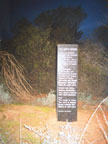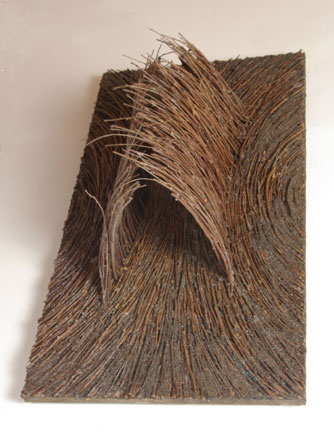Maquette for proposed 'Temple of the Golden Bowerbird'
 John Hayward after Ian Hamilton
John Hayward after Ian Hamilton
 |
|
|
Bowerbirds and the art of Ian Hamilton I sometimes teach biology and understand that for the vast majority of organisms sexual rather than asexual reproduction is the only option. Biologists have theories, but no consensus about how sexual reproduction arose and what its survival benefits, in a Darwinian sense, are. They do understand - and agree - that sexual reproduction has led to elaborate and seemingly wasteful and dangerous sexual displays such as the tail of the peacock, the antlers of a stag and the bower-building and dancing of the Family Paradisaeidae (Birds of Paradise and Bower Birds). Some biologists use Darwinian theory to explain that sex is the reason for poetry, music and art in general. Ian has approached some of these ideas
from a different, non science direction. When he first spoke
to me about his ideas back in 1978 I didn't understand what he
was talking about. His key idea - one that he has repeated to
me many times in the succeeding 30 or so years - was Now I see that some of what he was saying was not altogether unrelated to the more mechanistic theories of traditional science. Ian began his work on bowerbirds when he was an Artist in Residence, at Griffiths University in 1976. He went to O'Reilly's, outside Brisbane, where he filmed and videotaped Satin Bowerbirds (Ptilonorynchus violaceus) working on their bowers. Looking at a videotape record of a male bowerbird placing twigs, stepping back and considering his work, before darting in to change the position of a stick. Ian was struck by how similar that action was to the way artists step back and view work in progress. He developed the idea that the bowerbird was not unlike the archetypically male artist using 'free time' to create non-essential objects. He considered the notion that some species may, at certain times in history, have the luxury of free time (freedom from predation, territorial disputation and hunger) to indulge in non-essential behaviour. Ian became so interested that he did some reading and found out that the Golden Bower Bird (Prionodura newtoniana), which lives in the mountains of northern Queensland, built elaborate structures that were more like towers than bowers. He obtained a South Australian government grant to 'study the art of the Golden Bowerbird'. In Paluma, north-west of Townsville, he made contact with an academic ornithologist who showed him a bower/tower of the Golden Bower Bird (P. newtoniana). Ian set to work, in a manner that seemed to me very close to scientific, observing the natural history of P. newtoniana, finding 13 bowers/towers and observing them and their owner/builders over a period of several months. I spent a few days beside Ian observing his work in the rainforest and have read his notes and looked at sketches, drawings, photographs and super 8 films he made at the time. His methods - both fieldwork and notations - seem, at first sight, indistinguishable from the fieldwork and records of a scientist. This is particularly evident in the enlarged reworked facsimiles of pages from his notebooks. But Ian works with the eye and mind of an artist. He did not view the bowerbird as simply part of the natural world to be possessed, studied, catalogued and teased apart as it might be by a dispassionate scientist. He sees the bowerbird more like an artist. He sees the bowerbird's work as worthy of admiration for itself, no matter what the Darwinian may have to say about it. At first I did not understand one of his sketches that was later published in his 1983 publication, "Ceremony of the Golden Bower Bird" . The sketch showed a bird net stretched in the forest with a human figure trapped in it. The human figure is the artist (not the scientist that I originally took it to be) trapped, snared, made ineffectual by the scientist. Thus he drew a clear line between his work and sensibilities and that of the dispassionate professional ornithologist, who, in the legitimate pursuit of scientific studies, can net, tag, release or kill and preserve specimens. As a science teacher I sometimes find it difficult to understand Ian's thought processes. Like any artist he is sometimes unable to explain and understand all that he does himself. While his recent work lacks the high-energy performance art of the late 1970s, early 1980s (involving fluorescent and other lights in exploring ideas of the connections and interactions between nature and technology) there are at least three levels to his current output. At what I call the primary and least complex, but to me possibly most appealing, are the direct re-workings of his original notes and sketches. These are designed to sit on the wall like the open pages of a journal and convey the immediacy of fieldwork. At another level are works that respond to experiences and thoughts generated by earlier experiences. Here you will find new workings and interpretations, from various perspectives, of the forms and feelings of the bowers, still recognisably related to the raw materials. I think his wonderfully prepared and beautiful stylised bowers made from dry sticks span these two categories. And then there are works arising from places, feelings and impulses that even Ian doesn't understand, where pure artistic responses, welling up from the sum of nearly 40 years of involvement, thinking, feeling and processing in this one part of his work and artistic endeavour. These works lead into areas that can exasperate us too-rational science types and so may be the most profound and important. Leo Davis, 2005 The Ceremony of the Golden Bowerbird, Experimental Art Foundation, 1983 |
|
| 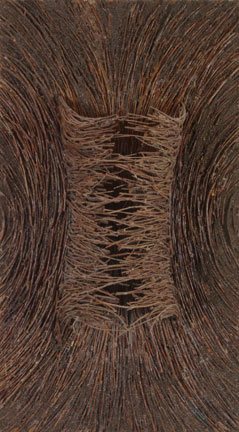
|

| 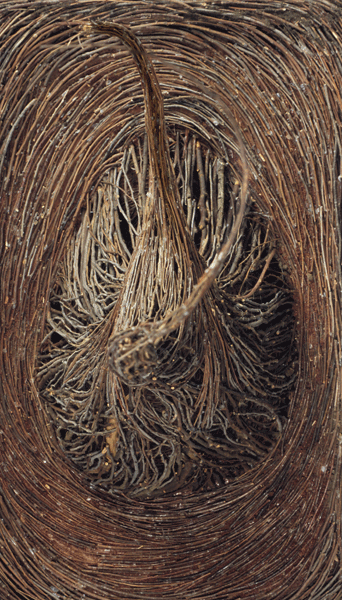
|
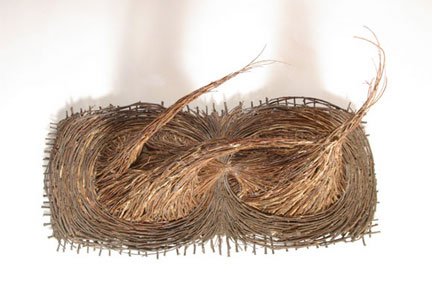

|
|
